
Exhibition and Education
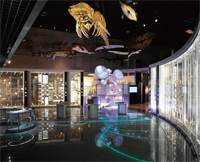
Tree of Life
: Global Gallery 1F
Exhibitions and Educational Programs
The Museum offers a diverse and attractive exhibitions, to have more visitors come to the Museum. In Ueno and in two other districts, the Museum offers permanent exhibitions as well as a series of special exhibitions and temporary exhibitions, focusing on themes of strong public interest and attention.
In educational programs, the Museum is implementing and disseminating solutions that provide vital leadership for scientific education in Japan. Working closely with academic and corporate partners, the Museum is offering a diverse range of specialized learning opportunities. The Museum is also disseminating educational model programs designed to foster science literacy utilizing exhibition spaces and creating innovative systems that foster close and productive working relationships with schools.
In educational programs, the Museum is implementing and disseminating solutions that provide vital leadership for scientific education in Japan. Working closely with academic and corporate partners, the Museum is offering a diverse range of specialized learning opportunities. The Museum is also disseminating educational model programs designed to foster science literacy utilizing exhibition spaces and creating innovative systems that foster close and productive working relationships with schools.
Exhibitions
Exhibition in Ueno
Each floor of National Museum of Nature and Science is organized around a unifying theme, informed by the Museum's rich and high-quality collection of original specimens and materials. Each floor's exhibitions work together to convey a message, in turn relating to the overarching message of the permanent exhibitions, “Human Beings in Coexistence with Nature.” By presenting these themes in a clear and systematic fashion, the Museum encourages visitors to think about what we can do to protect the environment in which all living things exist and to build a future of harmonious coexistence between people and the natural world.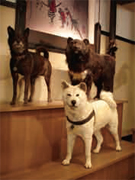
Akita-inu (Hachi),
Sakhalin Husky (Jiro),
Kai Dog
: Japan Gallery 2F North
Organized around the theme of “The Environment of the Japanese Archipelago,” the Japan Gallery offers exhibitions on the nature and history of the Japanese Islands, the process by which the modern population of Japan was formed, and the history of the relationship between the Japanese people and nature. The common purpose of these exhibitions is to express appreciation of and pride in Japanís natural environment and its culture, and convey it to foreign visitors in a way that is clear, concise and engaging.
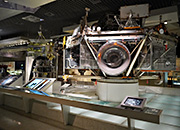
SFU:
Global Gallery 2F
The theme of the Global Gallery is “The History of Life on Earth” which explores the deep interrelationships among the earth's diverse living things, the evolution of life as environmental change drives a cycle of speciation and extinction, and the history of human ingenuity.
Tsukuba Botanical Garden
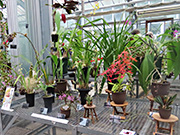
Tsukuba Orchid Exhibition
For details, please visit the page on Tsukuba Botanical Garden.
Institute for Nature Study
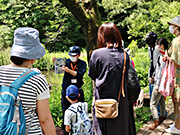
Sunday Walking Tour
The Institute offers an array of educational events, drawing on the professional expertise of its staff and its abundance of diverse plant life. For visitors, the Institute presents provides Nature Walks on Sundays, Natural History Seminars, and Nature Classes for Children. For teachers and instructors, the Institute offers trainings on nature observation and practical lessons in ecological research.
The Institute is an ideal for informal study by school pupils and students.
For details, please visit the Institute for Nature Study page.
Special Exhibitions
The diversity of exhibitions on display at the Museum is in a large part of the product of active partnerships and collaborative efforts between the Museum and cooperating organizations such as corporations and universities.
The Museum and its partners work together to create innovative ways of conveying the story of the exhibitions to the general public in accessible and engaging ways.
For details, please visit the Special Exhibitions page.
The Museum and its partners work together to create innovative ways of conveying the story of the exhibitions to the general public in accessible and engaging ways.
For details, please visit the Special Exhibitions page.
Educational Programs
Various Programs for Children and Adults
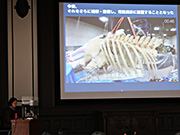
Discovery Talk
- In the “Discovery Talks”, offered on weekends and public holidays, Museum researchers take turns making direct presentations to visitors, explaining the results of their research work and answering questions.
- The Museum's “Natural History Seminars” and “Lectures on Natural History for University Students”; are lectures with a high degree of specialization, available to university students, as well as the general public.
- Certification of the Master of the Museum aims to promote youth studying using science museums, and foster positive attitudes toward science.
- Developing and promoting activities using the museum exhibits to foster scientific literacy.
The Museum is developing a communication-oriented activity model that uses museum exhibits for fostering scientific literacy. We accumulate and disseminate information for educational-support activities through the nation-wide network of science museums.
Strengthening Partnerships with Schools
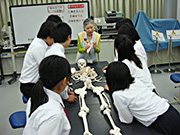
Learning program for school groups
In addition, the Museum operates a University Partnership Program, to contribute to improving studentsí science literacy and science communication skills.
- Partnering with schools:
We are developing and implementing study programs that enable effective collaboration between the schools and museums. The Museum offers worksheets that can be used for school visits to assist learning from museum exhibits. - Museum Open House for Teachers:
The Museum sponsors Museum Open House for Teachers, an opportunity when teachers can enjoy the Museum in their own way. This day is an opportunity for school teachers to come to the Museum and gain a deeper appreciation of the many ways they can make use of the Museum in teaching their classes about science. This is carried out in collaboration with regional science museums throughout Japan. - The University Partnership program for collaboration between the member institutions of higher learning:
Members enjoy benefits such as free entrance to permanent exhibitions, discounts for special exhibitions, and priority admission to Lectures on Natural History for University Students.
Personnel Training Programs for Science Communicators
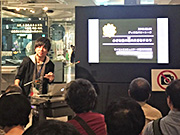
Science Communicator Training Program:
Discovery Talk by course participants
- Science Communicator Training Program:
The goal of this training course is “creating the link of knowledge” by way of a curriculum whereby theory is studied and then put into theory application. Students then examine questions raised in the theory application, and review the theory once more to resolve them. Participants who complete both SC1 and SC2 programs receive “NMNS Science Communicator Certificate” - Museum Practicum:
The Museum offers two courses for university students seeking qualification as curators. One course provides hands-on training in the skills and disposition needed to manage research activities and collect and preserve specimens, and the other provides hands-on training in project development for education-supportive exhibitions.
Volunteer
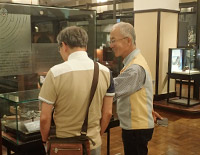
Floor Guide
(1F South Japan Gallery)
The Ueno district introduced the volunteer system in 1986, and since then, the “Kahaku Volunteers” take part in educational programs, serving as exhibition guides, and supporting in various educational programs. They promote science communication in the exhibition galleries by speaking directly with the visitors, particularly when serving as floor guides or taking part in the “Touch and Talk Wagon.”
“Botanical Garden Volunteers” registered in the Tsukuba Botanical Garden, as well as “Shizen-en Volunteers” registered under the new 2019 volunteer system, are enthusiastically contributing their services as garden guides or in educational programs in each district.